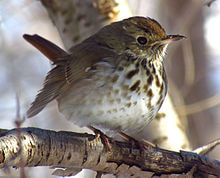|
When I awaken before dawn each morning I stay in bed to listen to the first flute-like calls of the Hermit Thrush that nests every year down by my brook. Its poignant melancholy song begins with a single high note that ascends in an upward spiral, and for me it is probably the most beautiful bird song I have ever heard. Although I rarely catch a glimpse of a Hermit Thrush when I do I recognize them instantly because these birds are quite beautiful with their rusty brown coloring, distinctly spotted breasts and reddish tails. Occasionally I have seen one while hiking through an open forest. Hermit Thrushes live in a wide variety of habitats, ranging from boreal forests of the far north to deciduous woods and mountain forests. Look for them in open wooded areas - trails, pond edges, mountain glades, or areas partially opened up by fallen trees. In winter, Hermit Thrushes often occupy lower-elevation forests with dense understory and berry bushes, including pine, broadleaf evergreen, and deciduous woods. Hermit Thrushes are frequent winter visitors across much of the country, including New Mexico. Apparently, non – breeding populations live in New Mexico year round, at least in the high country, a fact that surprised me. Early last spring while visiting near Taos I heard one singing in a juniper pinion forest and then wondered if I had imagined it. Most Hermit Thrushes migrate south in late autumn, and are among the first to head north in spring to their chosen breeding grounds.
Hermit Thrushes forage on the forest floor by rummaging through leaf litter or seizing insects. When they’re about to fly, they flick their wings or tails. The Hermit Thrush may respond to predators by crouching and pulling back its head. During courtship, the male chases the female in circles, then the pair adopts a slower flying pattern after one or two days. In spring, they eat mainly insects - beetles, caterpillars, bees, ants, wasps, and flies. They also occasionally eat small amphibians and reptiles. In the winter, Hermit Thrushes change their diet to eat more fruit, including wild berries. Depending upon the area nests can be found on the ground, in small trees or shrubs; in this area I found one nest in a beech tree sapling. Open spaces near berry and fern thickets, pasture edges, and forest roads are common sites and this year I think my hermit thrush is nesting in the ferns just below the house. The cup-like nest is built with grass, twigs, lichens, mosses and mud; the female incubates four eggs for about 13 days. Males usually gather food for the nest, while females feed the nestlings. The young birds start by eating bits of larvae, then grasshoppers, moths, and spiders. One Hermit Thrush has been seen trying to give a nestling a salamander. Hermit Thrushes make several distinct calls around their nests. They will sometimes make a sound similar to a canary call. Females frequently rearrange their eggs while making another kind of noise. Adults meeting at the nest greet each other with a special call. Hermit Thrushes rarely visit backyards and generally do not visit feeders. However, during migration, they often forage on the ground or eat berries in yards with trees or shrubs. Now that I know that non –breeding populations really exist in NM I will be on the look out for one of these birds during the winter months. Meanwhile, I listen to the song of the Hermit thrush with gratitude in my heart.
0 Comments
Your comment will be posted after it is approved.
Leave a Reply. |
Submit your ideas for local feature articles
Profiles Gardening Recipes Observations Birding Essays Hiking AuthorsYou! Archives
September 2025
Categories
All
|

 RSS Feed
RSS Feed